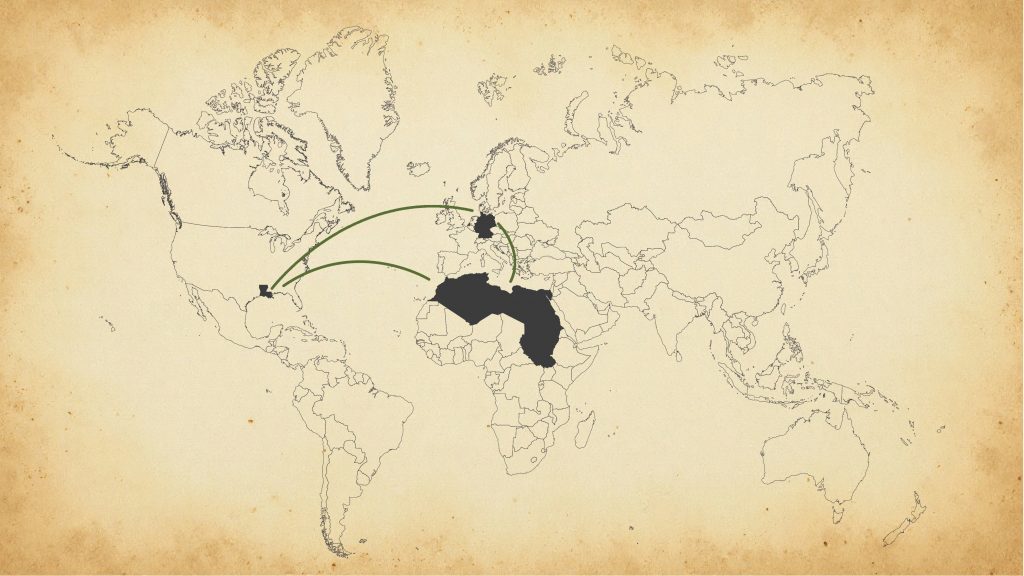The North African Campaign

kade bergeron features editor Prisoners of war engaged in a variety of recreational and creative activities during their time in captivity. From playing soccer and card games to painting and woodworking, these activities offered the prisoners both physical and mental respite. For most of the day, the prisoners of war worked in fields and were occasionally allowed to enjoy recreational activities. Everet Hallback, whose father worked as a mechanic while the POW camps were in South Louisiana, says the prisoners enjoyed playing with the stray dogs while waiting for transportation back to the camps. And some liked to play various card games once they got back to the camps. Glenn Falgoust, a journalist who researched the Donaldsonville POW camps, says, “They played soccer, had a little sports field, and a dance hall.” “They played soccer, had a little sports field, and a dance hall.” Glenn falgoust In addition, some prisoners painted. Linda Theriot, an executive at The Houma Regional Military Museum, says a Houma camp prisoner, Otto Webber, painted multiple paintings, including a self portrait with his son. Some prisoners were interested in woodworking and masonry. “Sometimes there were training walls, like along a ditch or steps up to a house or up a hill,” says Brian Davis, executive director for the Louisiana Trust for Historic Preservation, about the Ruston camp. “Some of them were laid out by prisoners who would do work details out in the community at the time as well.” However, not all activities were physical like playing sports. Some of the activities were there to help the prisoners spiritually or mentally. A few camps allowed Catholic Mass for prisoners. In addition, Theriot says some prisoners may have been taught by teachers employed by their employer’s families — like the Matherne family who employed POWs from one of the Houma camps. The Battle in North Africa Most of the POWs held in Louisiana were captured in North Africa, more than 3,000 miles from their homes in Germany and more than 7,000 miles from Louisiana. Maps of the Axis advances in North Africa 1941. Photo Credit: The United States Military Academy Department of History Allied troops marching through Tunis following Allied success against Axis forces in the African Campaign. Tunis, Tunisia, May 20, 1943. Photo Credit: Library of Congress Panzer tanks of Erwin Rommel_s Africa Corps during an advance against British armed forces. Libya, 1941-1942. Photo Credit: National Archives and Records Administration, College Park, MD A British infantryman capturing a German tank crewman at El Alamein, 1942. Photo Credit: National Army Museum British troops help a wounded German prisoner, 1942. Photo Credit: National Army Museum British troops arrive in Tunis, May 1943, where the German P.O.W.s fought and were captured. Photo Credit: National Army Museum German prisoners of war under guard by a signpost to El Alamein, 1942. Photo Credit: National Army Museum Infantry moving up during 1st Army’s attack on Longstop Hill, Tunisia, April 1943. Photo Credit: National Army Museum New Zealander soldiers capturing Germans, December 3, 1941. Photo-Credit: Imperial War Museums
Life in Germany

Most of the POWs held in Louisiana came from Germany, more than 5,000 miles away from Louisiana. Bastei Bridge (Basteibrucke) with Lilienstein Mountain on background – Bastei, Saxony, Germany City hall of Wernigerode, Germany. Present-day Saxony, Germany, where many-German P.O.W.s originated. Photo Credit: Cheryl Call Dresden Cathedral of the Holy Trinity Hofkirche and Dresden Castle Hausmannsturm on Theaterplatz. Langelsheim, Niedersachsen, Germany. Photo Credit: Wolfgang Weiser Lauenburg-Elbe, Schleswig-Holstein, Germany. Photo Credit: Wolfgang Weiser Small village and Elbe river band in front of Bastei sandstone rocks in Saxony, Germany. kade bergeron features editor Prisoners of war engaged in a variety of recreational and creative activities during their time in captivity. From playing soccer and card games to painting and woodworking, these activities offered the prisoners both physical and mental respite. For most of the day, the prisoners of war worked in fields and were occasionally allowed to enjoy recreational activities. Everet Hallback, whose father worked as a mechanic while the POW camps were in South Louisiana, says the prisoners enjoyed playing with the stray dogs while waiting for transportation back to the camps. And some liked to play various card games once they got back to the camps. Glenn Falgoust, a journalist who researched the Donaldsonville POW camps, says, “They played soccer, had a little sports field, and a dance hall.” “They played soccer, had a little sports field, and a dance hall.” Glenn falgoust In addition, some prisoners painted. Linda Theriot, an executive at The Houma Regional Military Museum, says a Houma camp prisoner, Otto Webber, painted multiple paintings, including a self portrait with his son. Some prisoners were interested in woodworking and masonry. “Sometimes there were training walls, like along a ditch or steps up to a house or up a hill,” says Brian Davis, executive director for the Louisiana Trust for Historic Preservation, about the Ruston camp. “Some of them were laid out by prisoners who would do work details out in the community at the time as well.” However, not all activities were physical like playing sports. Some of the activities were there to help the prisoners spiritually or mentally. A few camps allowed Catholic Mass for prisoners. In addition, Theriot says some prisoners may have been taught by teachers employed by their employer’s families — like the Matherne family who employed POWs from one of the Houma camps. Most of the POWs held in Louisiana came from Germany, more than 5,000 miles away from Louisiana. Bastei Bridge (Basteibrucke) with Lilienstein Mountain on background – Bastei, Saxony, Germany City hall of Wernigerode, Germany. Present-day Saxony, Germany, where many-German P.O.W.s originated. Photo Credit: Cheryl Call Dresden Cathedral of the Holy Trinity Hofkirche and Dresden Castle Hausmannsturm on Theaterplatz. Langelsheim, Niedersachsen, Germany. Photo Credit: Wolfgang Weiser Lauenburg-Elbe, Schleswig-Holstein, Germany. Photo Credit: Wolfgang Weiser Small village and Elbe river band in front of Bastei sandstone rocks in Saxony, Germany.
POWS Path to Louisiana

